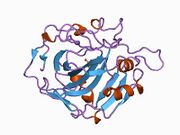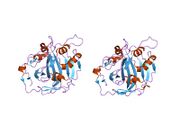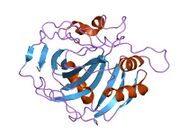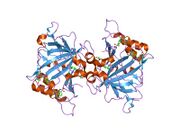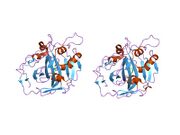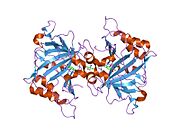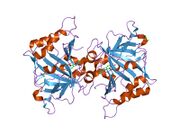Biology:CA1 (gene)
 Generic protein structure example |
Carbonic anhydrase 1 is an enzyme that in humans is encoded by the CA1 gene.[1][2]
Carbonic anhydrases (CAs) are a large family of zinc metalloenzymes that catalyze the reversible hydration of carbon dioxide. They participate in a variety of biological processes, including cellular respiration, calcification, acid-base balance, bone resorption, and the formation of aqueous humor, cerebrospinal fluid, saliva, and gastric acid.
They show extensive diversity in tissue distribution and in their subcellular localization. CA1 is closely linked to CA2 and CA3 genes on chromosome 8, and it encodes a cytosolic protein which is found at the highest level in erythrocytes. Transcript variants of CA1 utilizing alternative polyA_sites have been described in literature.[2]
Structure
The human CA1 protein contains an N-terminus active site, zinc binding site, and substrate-binding site.[3] The crystal structure of the human CA1-bicarbonate anion complex reveals the geometry of two H-bonds between the Glu106-Thr199 pair and the Glu117-His119 pair, and one pi H-bond between a water molecule and the phenyl ring of the Tyr114 residue. The product inhibition of CA1 via bicarbonate anions is correlated to the proton localization change on His119. So the Glu117-His119 H-bond is considered to regulate the ionicity of the zinc ion and the binding strength of the bicarbonate anion.[4]
Mechanism
The reaction catalyzed by CA1 is the same as other carbonic anhydrase family proteins:
- [math]\ce{ {CO2} + H2O ->[{}\atop\ce{Carbonic~anhydrase}] H2CO3 }[/math]
(in tissues - high CO2 concentration)[5]
The CA1-catalyzed reaction has a relatively low reaction affinity (Km) of 4.0 mM for CO2,[3][6] turnover number (Kcat) of 2×105 s−1, and catalytic efficiency (Kcat/Km) of 5×107 M−1s−1 comparing to other isozymes of the α-CA family of carbonic anhydrases. The turnover rate and catalytic rate of CA1 are only about 10% that of CA2 (Kcat: 1.4×106 s−1, Kcat/Km: 1.5×108 M−1s−1).[7]
Function
Carbonic anhydrase 1 belongs to α-CA sub-family and is localized in the cytosol of red blood cell, GI tract, cardiac tissues and other organs or tissues.[8] Transmembrane transport of CA-produced bicarbonate contributes significantly to cellular pH regulation.[9]
In a human zinc-activated variant of CA1, the Michigan Variant, a single point mutation changes His 67 to Arg in a critical region of the active site. This variant of the zinc metalloenzyme appears to be unique in that it possesses esterase activity that is specifically enhanced by added free zinc ions.[10]
Clinical significance
CA1 activation is associated with worsened pathological remodeling in human ischemic diabetic cardiomyopathy.[8] In diabetic mellitus type 2 patients with postinfarct heart failure who were undergoing surgical coronary revascularization, myocardial levels of CA1 were sixfold higher than nondiabetic patients. Elevated CA1 expression was mainly localized in the cardiac interstitium and endothelial cells. Furthermore, high glucose-induced elevation of CA1 hampers endothelial cell permeability and determines endothelial cell apoptosis in vitro.[8]
CA1 also mediates hemorrhagic retinal and cerebral vascular permeability through prekallikrein activation and serine protease factor XIIa generation. These phenomena induce proliferative diabetic retinopathy and diabetic macular edema disease progression, which represent leading causes of vision loss.[11]
As CA1 is an important therapeutic target, development of its inhibitors will contribute to disease treatment. Compared to other CA family members, CA1 has relatively low affinity to common CA inhibitors.[12] Nonetheless, it has medium affinity for CA inhibitor sulfonamides.[citation needed]
Interactions
CA1 has been shown to interact with:
These interactions have been confirmed using the high throughput method (one hit)
References
- ↑ "Physical mapping of the human carbonic anhydrase gene cluster on chromosome 8". Genomics 10 (4): 882–8. Aug 1991. doi:10.1016/0888-7543(91)90176-F. PMID 1916821.
- ↑ 2.0 2.1 "Entrez Gene: CA1 carbonic anhydrase I". https://www.ncbi.nlm.nih.gov/sites/entrez?Db=gene&Cmd=ShowDetailView&TermToSearch=759.
- ↑ 3.0 3.1 "CA1 - Carbonic anhydrase 1 - Homo sapiens (Human) - CA1 gene & protein". https://www.uniprot.org/uniprot/P00915.
- ↑ "Enzyme-substrate interactions. Structure of human carbonic anhydrase I complexed with bicarbonate". Journal of Molecular Biology 241 (2): 226–32. Aug 1994. doi:10.1006/jmbi.1994.1491. PMID 8057362.
- ↑ Carbonic acid has a pKa of around 6.36 (the exact value depends on the medium) so at pH 7 a small percentage of the bicarbonate is protonated. See carbonic acid for details concerning the equilibria HCO−3 + H+ ⇌ H2CO3 and H2CO3 ⇌ CO2 + H2O
- ↑ "Carbonic anhydrase catalyzes cyanamide hydration to urea: is it mimicking the physiological reaction?". Journal of Biological Inorganic Chemistry 4 (5): 528–36. Oct 1999. doi:10.1007/s007750050375. PMID 10550681.
- ↑ Silverman, David N.; Lindskog, Sven (2002-05-01). "The catalytic mechanism of carbonic anhydrase: implications of a rate-limiting protolysis of water". Accounts of Chemical Research 21 (1): 30–36. doi:10.1021/ar00145a005.
- ↑ 8.0 8.1 8.2 "Carbonic anhydrase activation is associated with worsened pathological remodeling in human ischemic diabetic cardiomyopathy". Journal of the American Heart Association 3 (2): e000434. 2014-01-01. doi:10.1161/JAHA.113.000434. PMID 24670789.
- ↑ "Quantification of carbonic anhydrase gene expression in ventricle of hypertrophic and failing human heart". BMC Cardiovascular Disorders 13: 2. 2013-01-01. doi:10.1186/1471-2261-13-2. PMID 23297731.
- ↑ "Crystal structure of a zinc-activated variant of human carbonic anhydrase I, CA I Michigan 1: evidence for a second zinc binding site involving arginine coordination". Biochemistry 41 (20): 6237–44. May 2002. doi:10.1021/bi0120446. PMID 12009884.
- ↑ "Extracellular carbonic anhydrase mediates hemorrhagic retinal and cerebral vascular permeability through prekallikrein activation". Nature Medicine 13 (2): 181–8. Feb 2007. doi:10.1038/nm1534. PMID 17259996.
- ↑ "Carbonic anhydrases: novel therapeutic applications for inhibitors and activators". Nature Reviews. Drug Discovery 7 (2): 168–81. Feb 2008. doi:10.1038/nrd2467. PMID 18167490.
- ↑ "A proteome-scale map of the human interactome network". Cell 159 (5): 1212–26. Nov 2014. doi:10.1016/j.cell.2014.10.050. PMID 25416956.
- ↑ "Toward an understanding of the protein interaction network of the human liver". Molecular Systems Biology 7: 536. 2011-01-01. doi:10.1038/msb.2011.67. PMID 21988832.
- ↑ "A directed protein interaction network for investigating intracellular signal transduction". Science Signaling 4 (189): rs8. Sep 2011. doi:10.1126/scisignal.2001699. PMID 21900206.
External links
- Human CA1 genome location and CA1 gene details page in the UCSC Genome Browser.
Further reading
- "Biochemical Genetics of Carbonic Anhydrase". Advances in Human Genetics. 7. 1976. pp. 1–56. doi:10.1007/978-1-4757-0659-8_1. ISBN 978-1-4757-0661-1.
- "Human carbonic anhydrases and carbonic anhydrase deficiencies". Annual Review of Biochemistry 64 (1): 375–401. 1995. doi:10.1146/annurev.bi.64.070195.002111. PMID 7574487.
- "Erythrocyte carbonic anhydrase I: inherited deficiency in humans". Science 197 (4302): 471–2. Jul 1977. doi:10.1126/science.406674. PMID 406674. Bibcode: 1977Sci...197..471K.
- "Crystal structure of human erythrocyte carbonic anhydrase B. Three-dimensional structure at a nominal 2.2-A resolution". Proceedings of the National Academy of Sciences of the United States of America 72 (1): 51–5. Jan 1975. doi:10.1073/pnas.72.1.51. PMID 804171. PMC 432238. http://repository.ias.ac.in/19034/1/307.pdf.
- "Treatment of Haemophilus aphrophilus endocarditis with ciprofloxacin". The Journal of Infection 24 (3): 317–20. May 1992. doi:10.1016/S0163-4453(05)80037-4. PMID 1602151.
- "Structure and methylation patterns of the gene encoding human carbonic anhydrase I". Gene 93 (2): 277–83. Sep 1990. doi:10.1016/0378-1119(90)90236-K. PMID 2121614.
- "Immunohistochemical observations on carbonic anhydrase I and II in human salivary glands and submandibular obstructive adenitis". Journal of Oral Pathology 15 (4): 187–90. Apr 1986. doi:10.1111/j.1600-0714.1986.tb00604.x. PMID 3088232.
- "Human carbonic anhydrase I cDNA". Nucleic Acids Research 15 (5): 2386. Mar 1987. doi:10.1093/nar/15.5.2386. PMID 3104879.
- "Assignment of the gene determining human carbonic anhydrase, CAI, to chromosome 8". Annals of Human Genetics 50 (Pt 2): 123–9. May 1986. doi:10.1111/j.1469-1809.1986.tb01030.x. PMID 3124707.
- "Human carbonic anhydrases. XII. The complete primary structure of the C isozyme". The Journal of Biological Chemistry 249 (8): 2329–37. Apr 1974. doi:10.1016/S0021-9258(19)42734-8. PMID 4207120.
- "[Primary structure of human B erythrocyte carbonic anhydrase. 3. Sequence of CNBr fragment I and III (residues 149-260)]". Biochimie 56 (8): 1031–43. 1975. doi:10.1016/S0300-9084(74)80093-3. PMID 4217196.
- "Amino acid sequence of human erythrocyte carbonic anhydrase B". Biochemical and Biophysical Research Communications 48 (3): 670–7. Aug 1972. doi:10.1016/0006-291X(72)90400-7. PMID 4625868.
- "Human carbonic anhydrases. XI. The complete primary structure of carbonic anhydrase B". The Journal of Biological Chemistry 248 (6): 1885–93. Mar 1973. doi:10.1016/S0021-9258(19)44161-6. PMID 4632246.
- "Population genetic studies of the Philippine Negritos. III. Identification of the carbonic anhydrase-1 variant with CA1 Guam". American Journal of Human Genetics 33 (1): 105–11. Jan 1981. PMID 6781336.
- "Marked zinc activation of ester hydrolysis by a mutation, 67-His (CAT) to Arg (CGT), in the active site of human carbonic anhydrase I". Human Mutation 4 (4): 294–6. 1995. doi:10.1002/humu.1380040411. PMID 7866410.
- "Carbonic anhydrase I and II as a differentiation marker of human and rat colonic enterocytes". Research in Experimental Medicine. Zeitschrift für die Gesamte Experimentelle Medizin Einschliesslich Experimenteller Chirurgie 198 (4): 175–85. Dec 1998. doi:10.1007/s004330050101. PMID 9879596.
- "Vasoconstrictive drugs increase carbonic anhydrase I in vascular smooth muscle while vasodilating drugs reduce the activity of this isozyme by a direct mechanism of action". Drugs Under Experimental and Clinical Research 27 (2): 53–60. 2001. PMID 11392054.
 |
